Sake from The Frozen North - Day 3, Thrills, and Spills: Rice Washing at Dewazakura; Soba Making
POSTED ON 30/03/2015By now accustomed to earlyish morning starts, we were driven at 8.30 am to Tendo City in Yamagata Prefecture for a morning visit to Dewazakura brewery, to be followed by a hands-on soba-making class. I was particularly excited at the prospect of visiting Dewazakura as I have very much enjoyed their sakes in the UK.
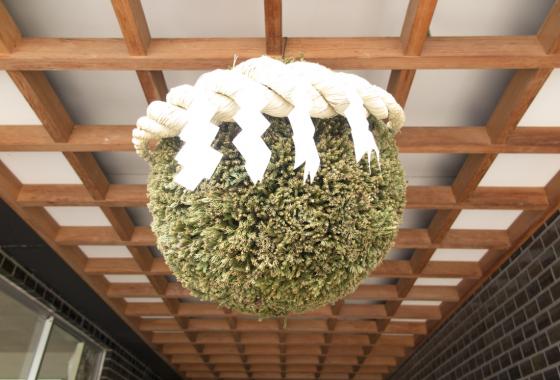 Welcome to Dewazakura - sugidama from Japanese cedar
Welcome to Dewazakura - sugidama from Japanese cedar
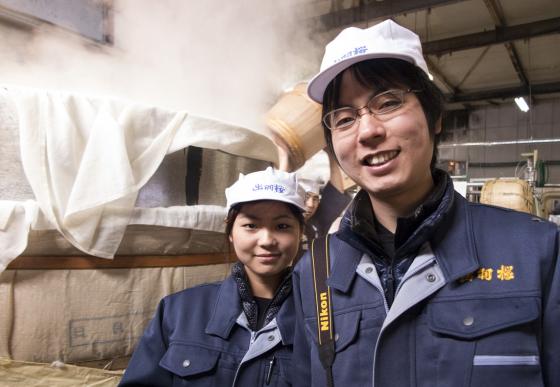 Akari and Shotaro Nakano
Akari and Shotaro Nakano
Founded in 1892 by the Nakano family, originally major landowners in the region, Dewazakura has a long history of making premium ginjo sake (http://www.dewazakura.co.jp/sake.htm). It has a Museum of Art which includes the craftwork of the Joseon Dynasty of Korea, and works of the painter Shinchi Saito. In modern times, the beguiling scent of its Oka Ginjo played a role in the development of the scent of a new product of SK-II, a cosmetic brand of P&G Max Factor. The ad is a bit cheesey but nicely done: https://www.youtube.com/watch?v=SR06SpavEWE&feature=youtu.be.
After meeting the brewery’s director and the seemingly impossibly young daughter of the owner, Akari Nakano, and her equally seemingly impossibly young husband Shotaro, we stepped, clad in white wellies, into the noisy, humid rice-steaming room. The highlight of the morning’s visit was entry into the kojimuro, the koji rice room, during the process of sprinkling the koji mould.
As we stood at one end of a narrow rectangular wooden room dominated by a huge wooden table, two workers spread the steamed yamadinishiki rice out on the table and then sprinkled the koji from a metal sprinkler over the rice.
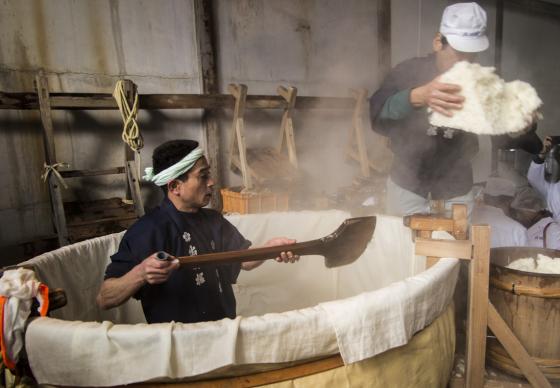 Scooping...
Scooping...
 ...out the...
...out the...
 ...steamed rice
...steamed rice
They deftly worked the glutinous-looking rice cake, mixing the koji into it with the aim of ensuring that every single grain of rice was infected by the koji mould. They then repeated the sprinkling, worked the rice cake some more, before covering it with a cloth and leaving the koji mould to sink in and do its enzyme-chopping work of converting starch to sugar. The process was virtually noiseless except for a quiet, soft scrunch-scrunching sound. Unusually for us, we watched the ritual in hushed reverence.
Halfway through the morning, we were taken to Mata Emon Soba, a nearby soba noodle joint where we were to learn how to roll out the rustic inaka style of buckwheat noodles from a master soba maker. Split into teams of three, we spent an absorbing hour or so mixing, kneading, pounding, rolling and cutting the mixture of buckwheat and flour into shape.
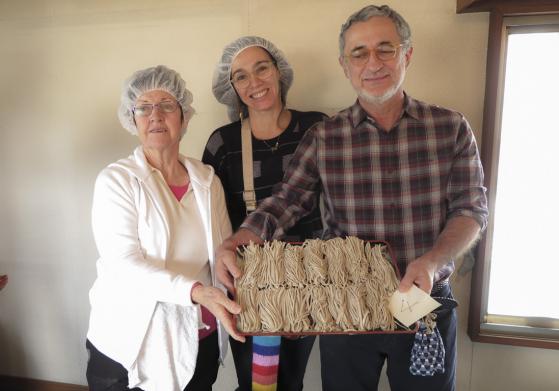 Coral, Maria Teresa and Roberto with their spoils
Coral, Maria Teresa and Roberto with their spoils
In this we were guided by a small, round woman, who went into a pogo-like dance of jumping up and down as she pummelled the buckwheat into submission. When the buckwheat was nicely rolled into a thin, square shape, we folded over the resulting thinned out square once, twice and a third time, ready to be sliced into thin noodles. These we consumed enthusiastically over lunch along with a large and tasty dish of tempura.
With rather more buckwheat than was desirable settling in our stomachs, it was time to return to Dewazakura and get down and dirty, or rather down and clean. Under the watchful lens of a TV crew and local journalists, we were to ‘help’ the brewery with its pre-steaming rice-washing. Six at a time, we were each given a mesh bucket containing 10 kilos of rice which we had to hold over the rim of a large orange plastic, baby-bath-size container of water, awaiting instructions as if in a TV reality show, which, come to think of it, we were.
At the given signal, we were to drop our mesh bucket into the baby bath and then stir the rice vigorously with one bare arm for 90 seconds. For some unaccountable reason, too much sake over lunch perhaps, I had a rush of blood to the head and instead of allowing the steel mesh bucket to sink into the water, tipped the rice straight into the bath, much to the barely contained mirth of the rest of the group and the consternation of the brewery’s toji (director of operations).
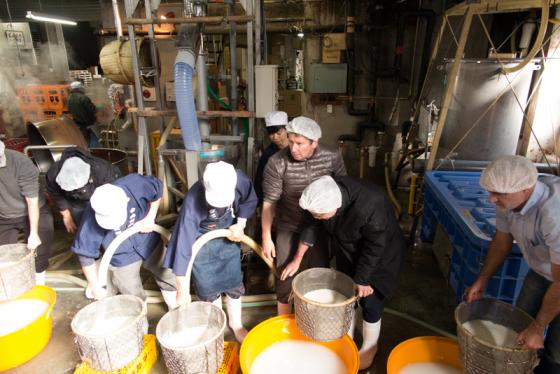 Trying my hand at...
Trying my hand at...
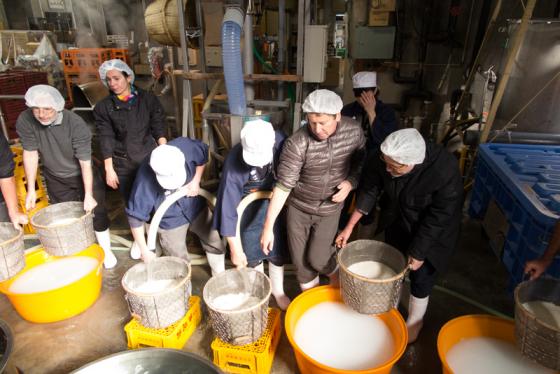 ...rice washing
...rice washing
No great harm was done and the process resumed. Stirring the rice vigorously in water at 4°C was the longest 90 seconds of my life. The veins stood out on my now brightly reddened ‘washing hand’. We then waited while the weight of the rice was checked to have increased to 12.4 kilos, and then a further kilo, before our mesh bucket back was returned to us. We each climbed a wooden ladder and this time I correctly tipped the rice into the giant wooden tub ready for steaming (and the making of Dewazakura’s Green Ridge Junmai Ginjo).
After all the excitement, we visited the moto room, the sake yeast room, with 19 tanks of yeast starters in various different phases of bubbling under. Then we moved to the fermentation area where 30 large tanks were going through different stages of fermentation, giving off pleasant odours of banana, pear and melon. We watched the pasteurisation process, basically the sake-filled bottles pasteurized at 65°C for 15 minutes. We then returned to the tasting room to taste a fantastic selection of Dewazakura sakes:
• Tobiroku Sparkling Nigori Sake
• Dewanosato Junmai
• Oka Ginjo
• Dewa33 Junmai Ginjo
• Omachi Junmai Ginjo
• Ichiro Junmai Daiginjo
• Yuki Manman Daiginjo Koshu
• Karesansui Junmai Koshu (warm)
 Pretty sake cups (ochoko)
Pretty sake cups (ochoko)
Our final visit of the day was to the two private museums of the Nakano family where we saw their private pottery collections and an atelier that the family had built for the local painter, Shinichi Saito.
At an early evening dinner, with local cuisine such as imoni, a typical local thick potato and meat soup, a variety of Dewazakura sakes were consumed, including a sparkling sake, a rich, smooth omachi junmai, a fragrant Ichiro Junmai Daginjo and a zingy-fresh, just-pressed unpasteurized namazake.
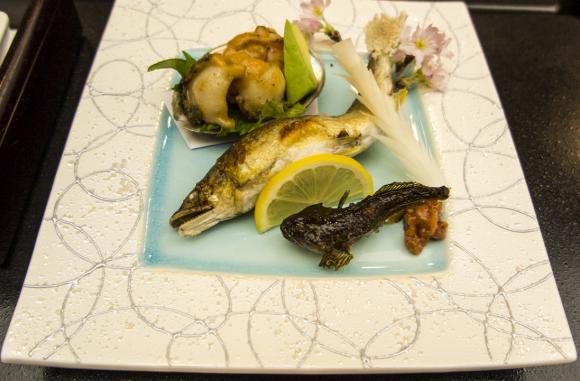 Ayu et al
Ayu et al
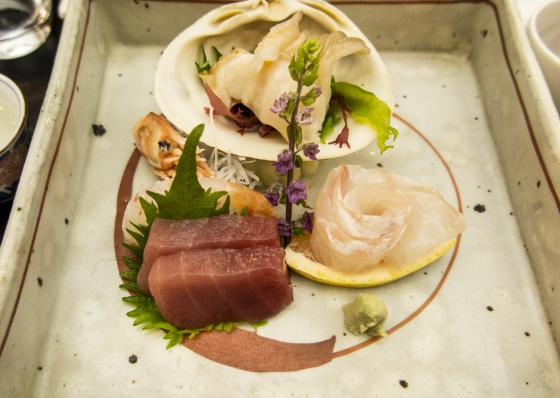 Say sashimi
Say sashimi
Apart from delicious local river fish such as the famous, slightly bitter ayu, one of the talking points was the shirako, or cod’s sperm sac. It wasn’t much to look at by my word was it softly juicy and umami-rich, chiming perfectly with an 10-year-old Karesansui Junmai. Dwight’s mum, Coral, initially baulking at the idea, thought that shirako was the dog’s b*ll*cks, as it were.
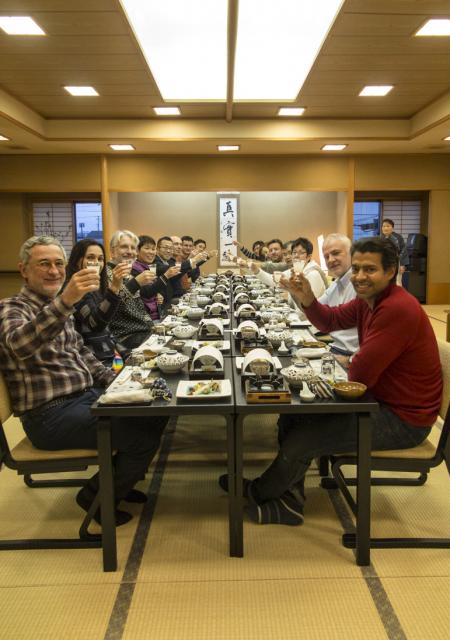 Kampai!
Kampai!

